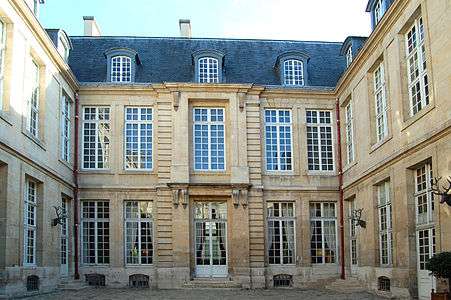Hôtel de Guénégaud

During the ancien regime there were several Hôtel de Guénégauds in Paris.
3rd arrondissement of Paris
At 60, rue des Archives, this Hôtel de Guénégaud was built between 1651 and 1655 for Jean-François de Guénégaud des Brosses, secrétaire du Roi, maître des Comptes and conseiller d'État, by François Mansart (the only hôtel particulier this architect built to have fully survived). It now houses the Musée de la Chasse et de la Nature and the Club de la chasse et de la nature. It is served by the Arts et Métiers and Filles du Calvaire Metro stations.
Left bank

Hôtel de Nevers
On the site of the present day Hôtel des Monnaies (1768), the Hôtel de Nevers[2] (on the quai de Nevers, just east of the Tour de Nesle) was purchased in 1646 by Henri de Guénégaud and transformed by the architect François Mansart into the Hôtel de Guénégaud in 1648–1652. The rue Guénégaud was created on the garden side of the hôtel. In 1670 ownership of this Hôtel de Guénégaud was transferred to one of Cardinal Mazarin's nieces, Anne-Marie Martinozzi, Princesse de Conti, and it became known as the Hôtel de Conti.[3] The quai de Nevers became the quai de Conti, but the name of the rue Guénégaud has remained unchanged up to the present day.
Guénégaud Theatre
In 1673 after the death of Molière the remnants of his company were forced to vacate their theatre in the Palais Royal. With poor prospects they merged with the players from the Théâtre du Marais and moved into a theatre on the rue des Fossés de Nesle (later the rue Mazarine), not far from the Hôtel de Conti. The theatre, previously known as the Salle de la Bouteille, a former tennis court (jeu de paume) which in 1671 had been converted into a theatre for the use of Pierre Perrin's Académie d'Opéra (see Paris Opera), became known as the Théâtre de Guénégaud.[4] It was located just across from the end of the rue Guénégaud, which, after the demolition of the Tour de Nesle and adjacent wall of Philippe Auguste during the construction of the Collège des Quatre Nations, had been extended as far as the rue Mazarine. For some unknown reason the company also referred to the theatre as the Hôtel de Guénégaud, notwithstanding that their humble abode bore little resemblance to a grand hôtel particulier.[5] After merging with the troupe from the Hôtel de Bourgogne in 1680, the company became known as the Comédie-Française and continued to perform in the same theatre until 18 April 1689, when it opened at the Jeu de Paume de l'Étoile on the rue des Fossés-Saint-Germain-des-Prés (the southeastward extension of the rue des Fossés de Nesle). That section of the road is now called the rue de l'Ancienne-Comédie.[6][7]
References
Notes
- ↑ Nuitter and Thoinan 1886, pp. 146–148; see also Clarke 1998, pp. 13, 59–60, 270.
- ↑ This Hôtel de Nevers should not be confused with one on the right bank on the rue de Richelieu which was part of the Palais Mazarin and was later incorporated into the old Bibliothèque Nationale de France; see also French Wikipédia Hôtel de Nevers (rue de Richelieu). A garden gallery of the latter hôtel had been designed by François Mansart ca. 1644–45 and was originally part of the immediately adjacent Hôtel Tubeuf, to which Mansart also made alterations; see also French Wikipédia Hôtel Tubeuf (rue des Petits-Champs). Of Mansart's designs only the exterior, and not the interior, of the garden gallery survives in somewhat altered form, with crossed quivers and garlands typical of Mansart visible above the upper windows (Braham and Smith 1973, pp. 70–73, 223–226, plates 318, 319; photo at Commons).
- ↑ Braham & Smith 1973, pp. 237–241.
- ↑ Clarke 1998, pp. 13–14. Clarke most often refers to the theatre as the Hôtel Guénégaud; Forman 2010, p. 127, uses the name Théâtre de Guénégaud; Wiley 1960, p. 320, indexes it under "Guénégaud, Hôtel (Théâtre) de".
- ↑ Powell 2000, p. 62. According to Clarke 1998, p. 13, Hôtel Guénégaud, with the particule "de" omitted, is often used, particularly in the more recent literature.
- ↑ Lecomte 1905, p. 20.
- ↑ Clarke 1998, pp. 1, 112.
Sources
- Braham, Allan; Smith, Peter (1973). François Mansart. London: A. Zwemmer. ISBN 978-0-302-02251-1.
- Clarke, Jan (1998). The Guénégaud Theatre in Paris (1673–1680). Volume One: Founding, Design and Production. Lewiston, New York: The Edwin Mellen Press. ISBN 978-0-7734-8392-7.
- Forman, Edward (2010). Historical Dictionary of French Theater. Lanham: The Scarecrow Press. ISBN 978-0-8108-4939-6.
- Lecomte, Louis-Henry (1905). Histoire des théâtres 1402–1904. Notice préliminaire. Paris: Daragon. View at Google Books.
- Nuitter, Charles; Thoinan, Ernest (1886). Les Origines de l'Opéra français (in French). Paris: E. Plon, Nourrit et Cie. Copies 1 and 2 at Google Books.
- Powell, John S. (2000). Music and Theatre in France 1600–1680. Oxford: Oxford University Press. ISBN 978-0-19-816599-6.
- Wiley, W. L. (1960). The Early Public Theatre in France. Cambridge, Massachusetts: Harvard University Press. OCLC 331219. Greenwood Press reprint (1973): ISBN 978-0-8371-6449-6.